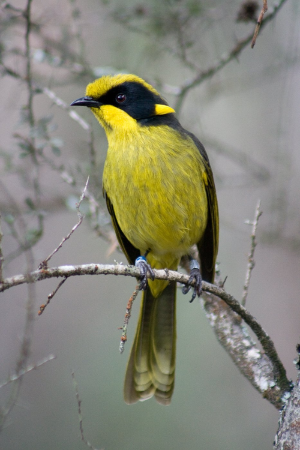
Duo Eclettico: Music Inspired by Birds
Pianist Coady Green of Duo Eclettico explores the musical vibrancy of birdsong.
Coady Green is one half of Duo Eclettico, a unique pairing of piano and saxophone with fellow musician Justin Kenealy. The Duo’s upcoming concert Run, Sing, Fly, (Wednesday 26 May), explores the musical vibrancy of birdsong. Coady shares his fascination with birdsong and why the Duo has chosen to explore music of the natural world in this recital.
Birdsong is the singing or calling of birds. It is something that I have been fascinated by since I was a teenager, and I spent several years learning large swathes of the solo piano music of Olivier Messiaen, including sections from his Catalogue d’Oiseaux. The sounds that birds produce can be categorised into two classes: calls and songs. A call is usually a short and simple vocalisation that signals flight or danger. A song tends to be a long and complex vocalisation produced during a breeding season.
For Run, Sing, Fly, Justin and I felt drawn to works that express messages on nature, partly as a response to the ever-growing concerns over climate change. Discussing this theme, we found a large variety of music for saxophone and piano which centres on the natural world, including works by Australian composer Dr. Jane Hammond and Japan’s Takashi Yoshimatsu that explore birdsong in a variety of ways.
Vivid landscapes, vibrant sounds
We believe that there is a uniqueness of colour in Australian music that is not found elsewhere in the world. This is often inspired by the stunning individuality of Australian flora, fauna and landscapes, where colours are so vivid and you can hear some of the most unusual and exciting sounds and rhythms from the natural world.
Dr. Jane Hammond’s new work, Songs from the Box and Swamp, tells the story of the critically endangered Helmeted Honeyeater and its habitat in the 50th anniversary year of this native Victorian bird being made our State avifaunal emblem. Specifically written for this program, the new commission is a deeply personal statement on the ongoing effects of human behaviour and climate change on the environment expressed as a tribute to Messiaen. Contained within this piece are stories of these birds, their habitat, the people who are dedicating their lives to keep them alive and protected, and the rich Indigenous backdrop to this narrative.

Jane, Justin and I have travelled to Yellingbo Reserve to visit the small group of conservationists who work tirelessly to protect and grow the Helmeted Honeyeater numbers. Once a prolific species thriving in Victoria, due to human behaviour, the numbers of Helmeted Honeyeater dropped to only 50 in the world. It is through the work of the Friends of the Helmeted Honeyeater that the numbers have now risen to 250 birds in the wild, all within a small area at Yellingbo. It is a remarkable and very moving story. Jane’s work is comprised of short movements based upon various aspects of the habitat and the life of the birds and conservationists.
Where nature and humankind intertwine
Japan’s renowned Takashi Yoshimatsu has composed works that feature programmatic representations of birds and juxtapose their natural habitat with the world of modern humankind for decades.
Like Messiaen before him, birds and their songs act as one of the most important sources of inspiration for Yoshimatsu. He refers to birds as the greatest ‘melody makers’, the motion of their wings and their movements whilst on the ground becoming intricate sources for a variety of rhythms, and their very lifestyles becoming a profound mode of musical expression.
His prolific output is peppered with titles such as the concerto for saxophone, piano and orchestra, Cyber Bird; his marimba concerto, Bird Rhythmics; and his sixth symphony, Birds and Angels. His music often contains long passages beautifully coloured by birdsong. His famous Fuzzy Bird Sonata for alto saxophone and piano, presented in our first program at the Centre, has three movements: Run Bird, Sing Bird and Fly Bird, and constitutes a central part of Yoshimatsu’s ‘bird series’. Yoshimatsu’s very virtuosic bird runs and flies between various musical styles, including classical, folk and jazz.
Yoshimatsu uses a variety of extended techniques on the saxophone to create his ornithological effects, including ‘slap tongue’ (the bird walking around), breath sound and key slaps (wings fluttering), portamenti (bird singing soulfully) and use of ostinato rhythms and brilliant altissimo (bird taking off into flight).
Albright Comes to Melbourne At Last
These two works will be performed together with Messiaen’s studen William Albright’s monumental Sonata for Saxophone and Piano – a work that through use of traditional Baroque and modern jazz techniques, specifically unites two different instruments and two different periods into a piece dedicated to the poignancy of human feeling and understanding. The Albright Sonata, whilst being a staple of the saxophone and piano repertoire internationally since its conception in 1984, has until now not been performed in Melbourne.
Friends of the Helmeted Honeyeater do incredible work not only to help the bird species, but to protect and grow native plant life in the Yellingbo area. Membership of the society can be gained through their website, through which donations can also be made: helmetedhoneyeater.org.au
Duo Eclettico performs Run, Sing, Fly in the Primrose Potter Salon on Wednesday 26 May. Click here to find out more and to book tickets.
You might also be interested in
-
-
Flinders Quartet celebrates its 20th anniversary in 2020.
-

